Korea: 7 Must-Have Apps for Digital Nomads (2025)
Forget about Google Maps, Uber, and Amazon. In Korea, Naver, Kakao, and Coupang are kings.
In most countries, we use the same apps. There’s often one or two that are specific to a place, but in Korea, forget all about Google Maps, Uber, Amazon...
Enter a new world where Naver, Kakao, and Coupang rule.
In this highly protected kingdom, you won’t be able to use some of the most local apps, as you’ll need a verified phone number to log in or be able to pay. But don’t worry, Korea has made a lot of progress with this in recent years, and the apps we’ve listed can be used whether you have a visa or not.
Spoiler alert: you can now use Coupang and (if you have a VISA card) even Coupang Eats!
We prepared a guide to explain this online adventure with all the major apps that you’ll need, as well as a little FAQ at the end.
Map Apps
Google Maps only works for one thing in Korea: finding vegetarian or vegan restaurants. For the rest, you’ll need a local navigation app like Naver Map and Kakao Map, or, as a last resort, Citymapper. They are a bit more difficult to use, but they have a pretty good English mode nowadays, and you’ll actually get current and detailed information about anywhere you want to go.
Naver Maps
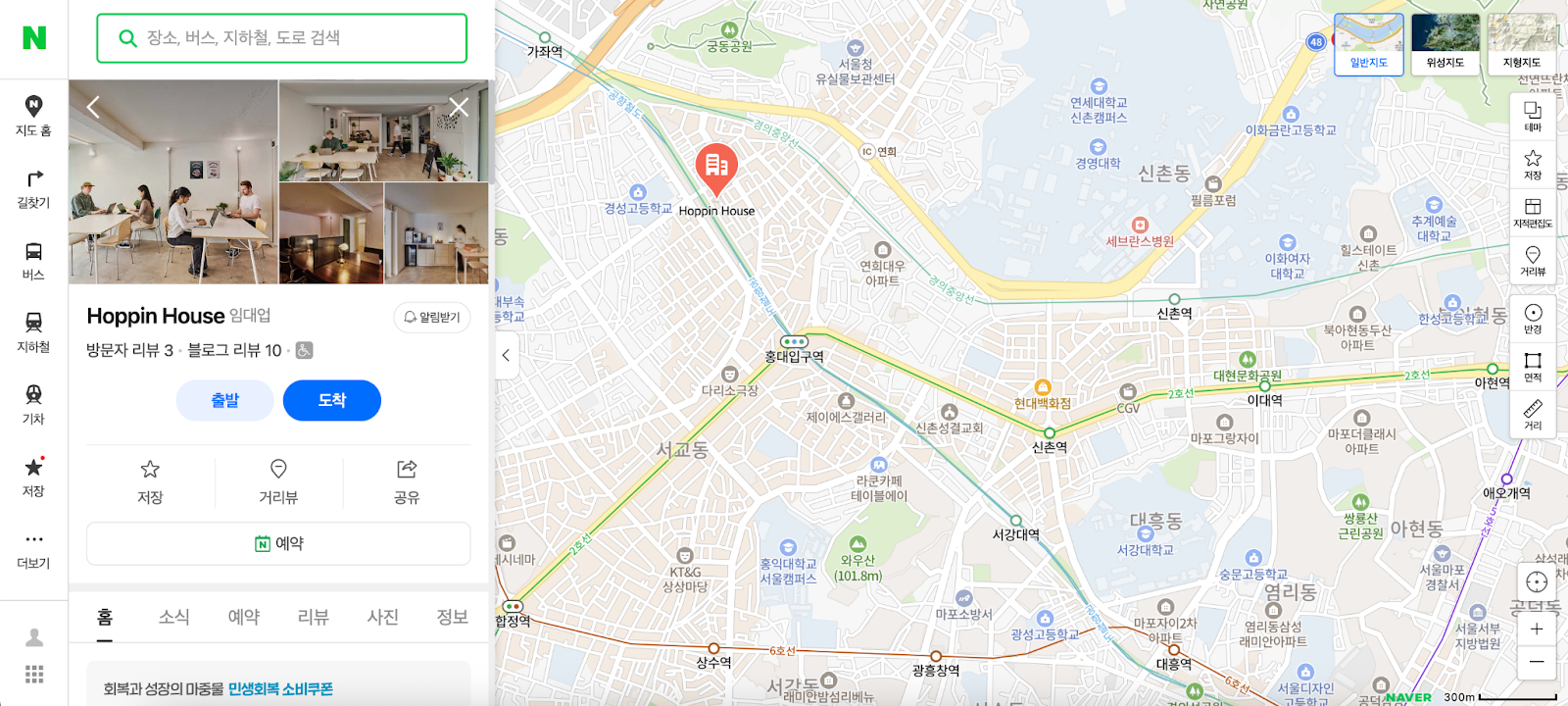
Naver Map is one of the two most-used navigation apps in Korea. It will help you figure out where to go, the opening time, check menus ahead of time, find directions, etc. For residents, it also lets you reserve train tickets, hotels, and many other services in-app. Easier to use than Kakao Maps for non-Korean speakers, Naver Maps usually displays the most updated information.
Naver Maps Tips
- Make sure to set the app fully to English by checking in the settings that ‘언어’ is properly set to ‘English’ and not ‘한국어’ (which means ‘Korean’).
- The app has a little quirk: to find a location by typing its name in English, you need to type it in lower caps, without a space. For example, we often organise Dinner & Drinks Meetups with our community at a bar called Beer O’Clock. To find it on Naver Maps, you’ll need to type ‘beeroclock’.
Kakao Map
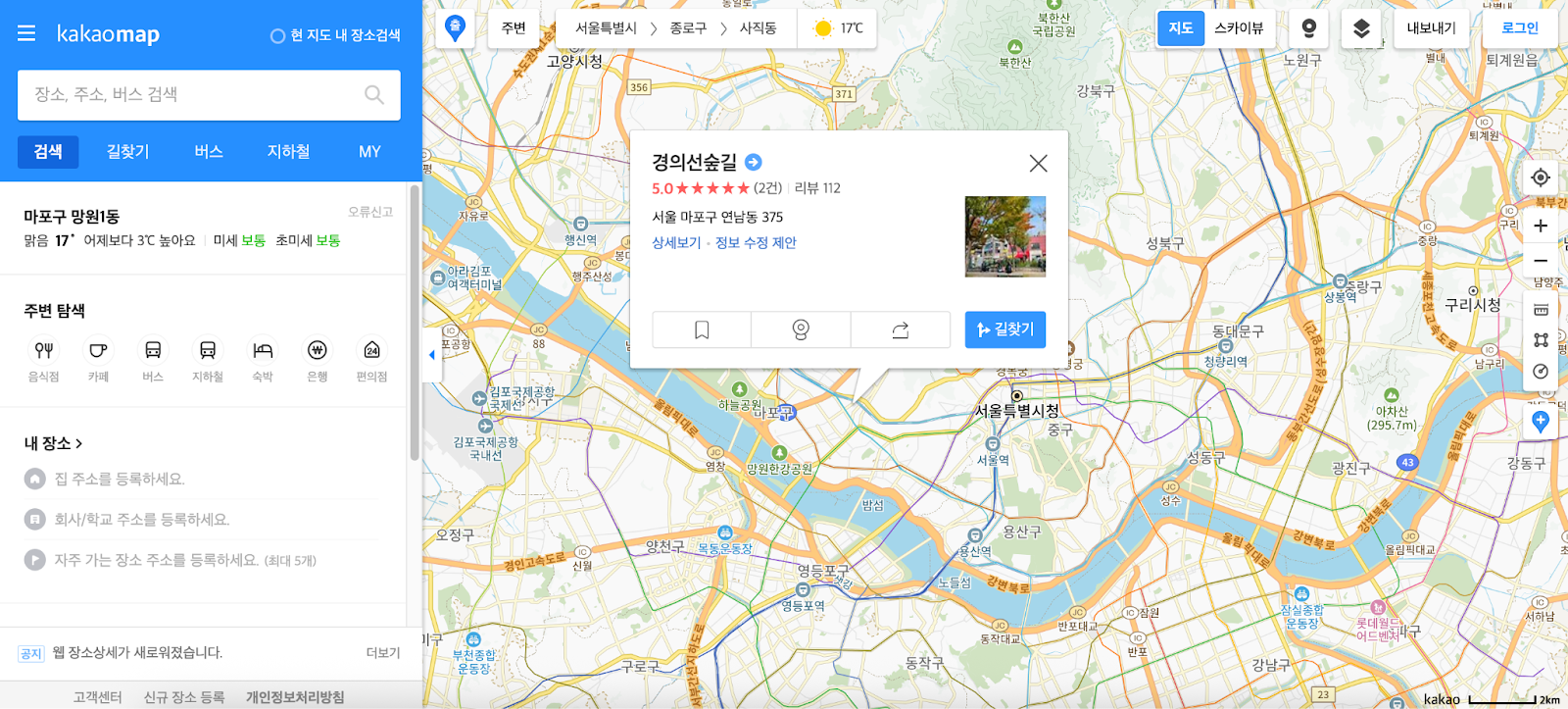
Similar to Naver Maps, Kakao Maps focuses less on business and more on real-time traffic navigation. Ratings and reviews for restaurants and cafes on Kakao tend to also be more believable than reviews on Naver, which is very heavily powered by ads. Bus timetables are also more accurate on Kakao than on Naver Maps. A feature even allows you to even see the bus location (you’ll see a little bus and its number displayed on the map), which helps you be more precise with traffic.
Kakao Map Tip
The app can also be more powerful in some cities in the countryside, depending on the contract negotiated with the local authorities. For example, in Jeju Island, there’s a bit more information on Kakao Maps.
Citymapper
Citymapper only works in Seoul, but it has the strong upside of being fully in English since it's a British app. Itineraries work great (the app gets its bus data from Kakao), and you’ll find most places (restaurants, cafes, etc) on the app!
Messenger App
There’s only one messaging app that governs them all in Korea…
KakaoTalk

If you want to get a taste of local life, your best bet is downloading KakaoTalk, the messaging app used by more than 90% of Koreans. You’ll enjoy super cute stickers, being able to schedule your posts (press the sending icon for a few seconds to get the option), and great group functionalities.
Taxi App
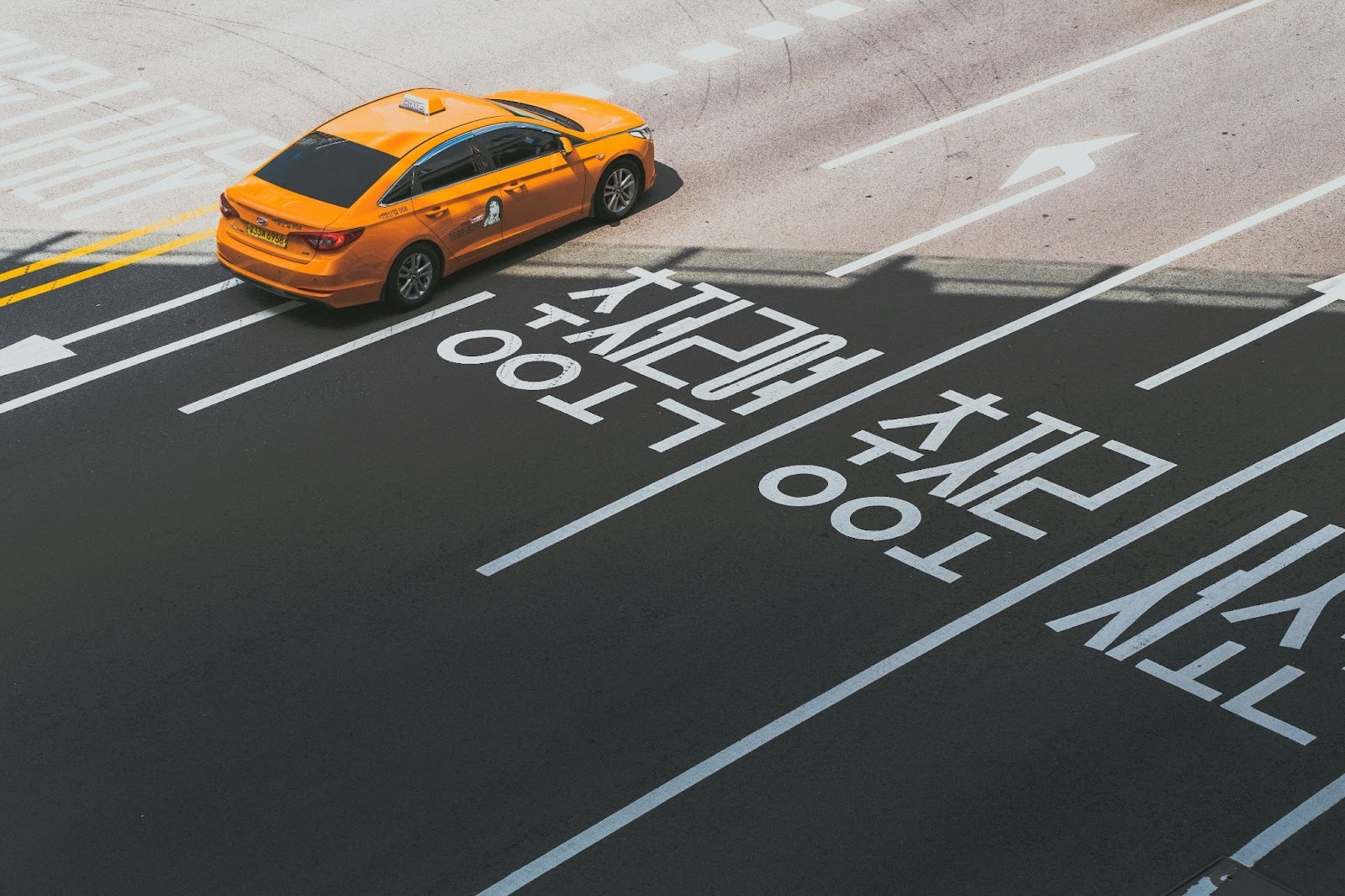
Except in dedicated taxi lanes, the use of taxi apps has become so big it has actually become difficult to grab a taxi by waving in the street. Instead, use KakaoT or Uber.
KakaoT
The KakaoT (ex-Kakao Taxi) app is used all over the country. You can use it to book a taxi and pay for it in-app. Other services are available, like renting a bike, an e-scooter, transporting pets, booking train tickets, etc. It works like Uber and Grab - letting you choose different types of rides according to how many people you are, which level of luxury you desire, etc.
KakaoT Tips
- You can select that you want to pay the taxi driver in person (by card, cash, or T-money card), but this might reduce your options since some cabs only accept in-app payment.
- The government and Kakao launched another app, K-ride, before KakaoT added the option to pay directly with a foreign card in the app. Once that feature was added, K-ride stopped making as much sense... We recommend that you just use KakaoT right away.
Uber
Like in most countries, Uber exists in Korea and works well. You might get fewer choices for taxis, and prices might be a bit higher than on KakaoT.
Translation Apps
Papago
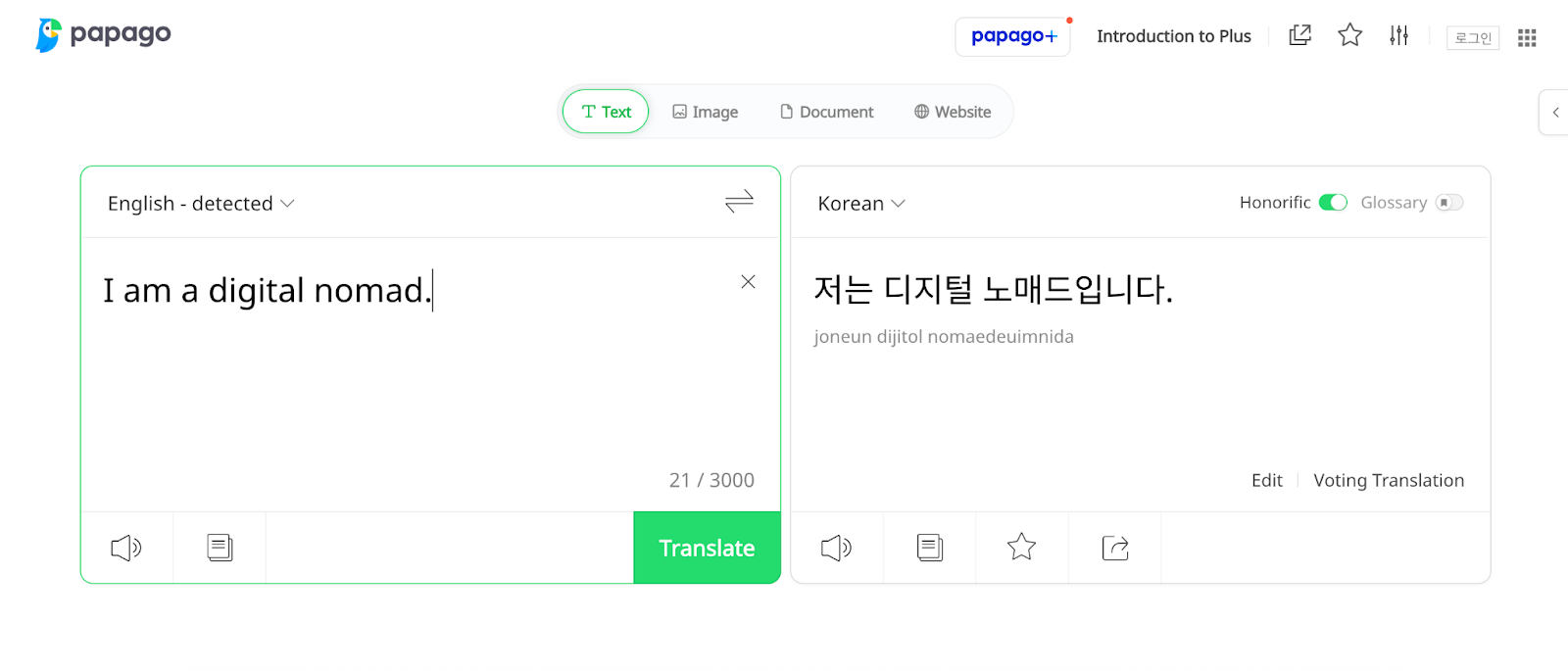
Papago, a local option powered by Naver, is the best option when you want to translate voice memos. Paired with the Naver dictionary app, Papago is also great if you’re looking for the translation of one or two words. For sentences or bigger texts, prefer Deepl or AI.
Deepl

Specifically trained to translate in specific languages, Deepl does much better than Google or Papago when it comes to longer texts. It picks up on nuances and was a game-changer before AI came along.
AI
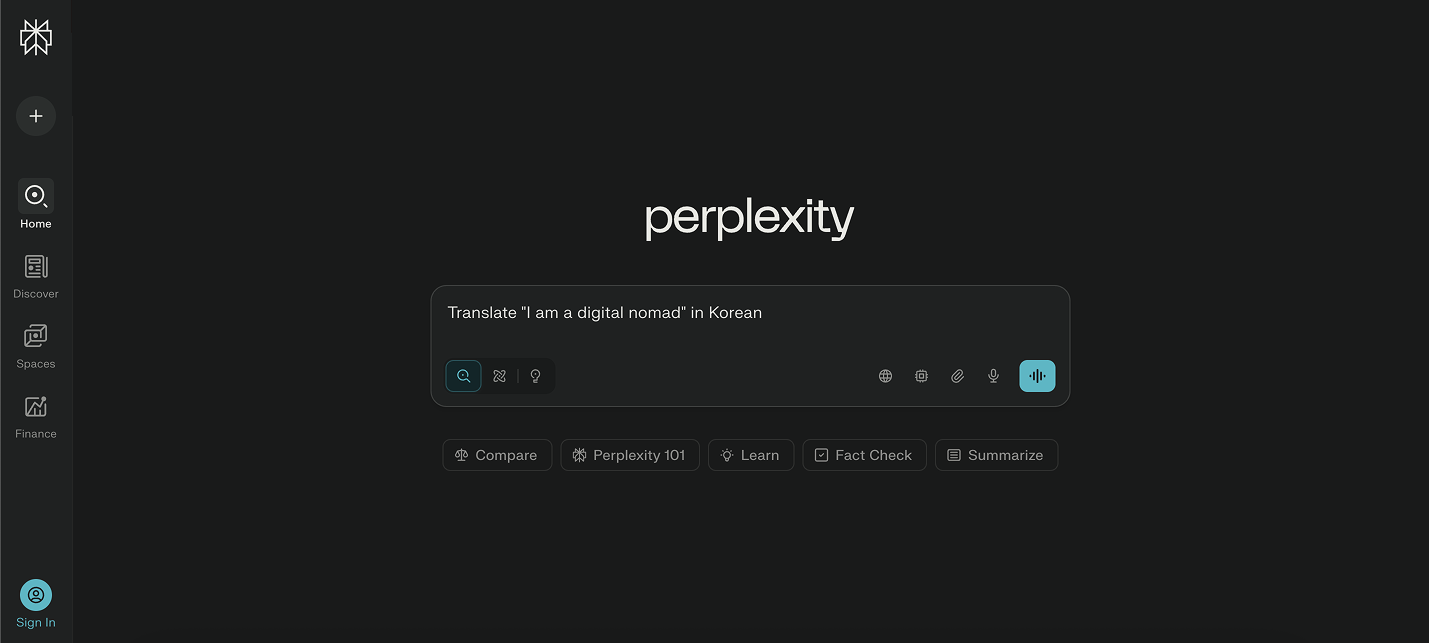
When it comes to translating Korean - a highly contextual language - AI does very well. The AI landscape is changing very fast right now, so it’s hard to keep up with the latest releases, but Perplexity and ChatGPT are our current favorites. You can also use Perplexity for image translation by dragging and dropping an image and asking to translate the text that’s on it.
Google Traduction
For live-image translation, Google Translate remains the fastest and best option out there.
Delivery App
Coupang

Forget Amazon. Korea has Coupang! You can find nearly anything there: furniture, food, plants… They’ll often arrive on the next day, maybe even on the same day if you have a resident card and subscribe to their WOW membership. Coupang is a necessity for many households.
How to use Coupang with a foreign card
If you are not a resident, your first order might require a bit of patience. Here’s how you can order on Coupang without a verified phone number:
- You can order on the Coupang app only, not the website.
- Choose your products, add them to your baskets, then proceed to order.
- You’ll need to give a local phone number (any local number works) and your address.
- In the payment method (결제수단), choose that you want to pay by card: 신용/체크카드 (Credit / Debit card).
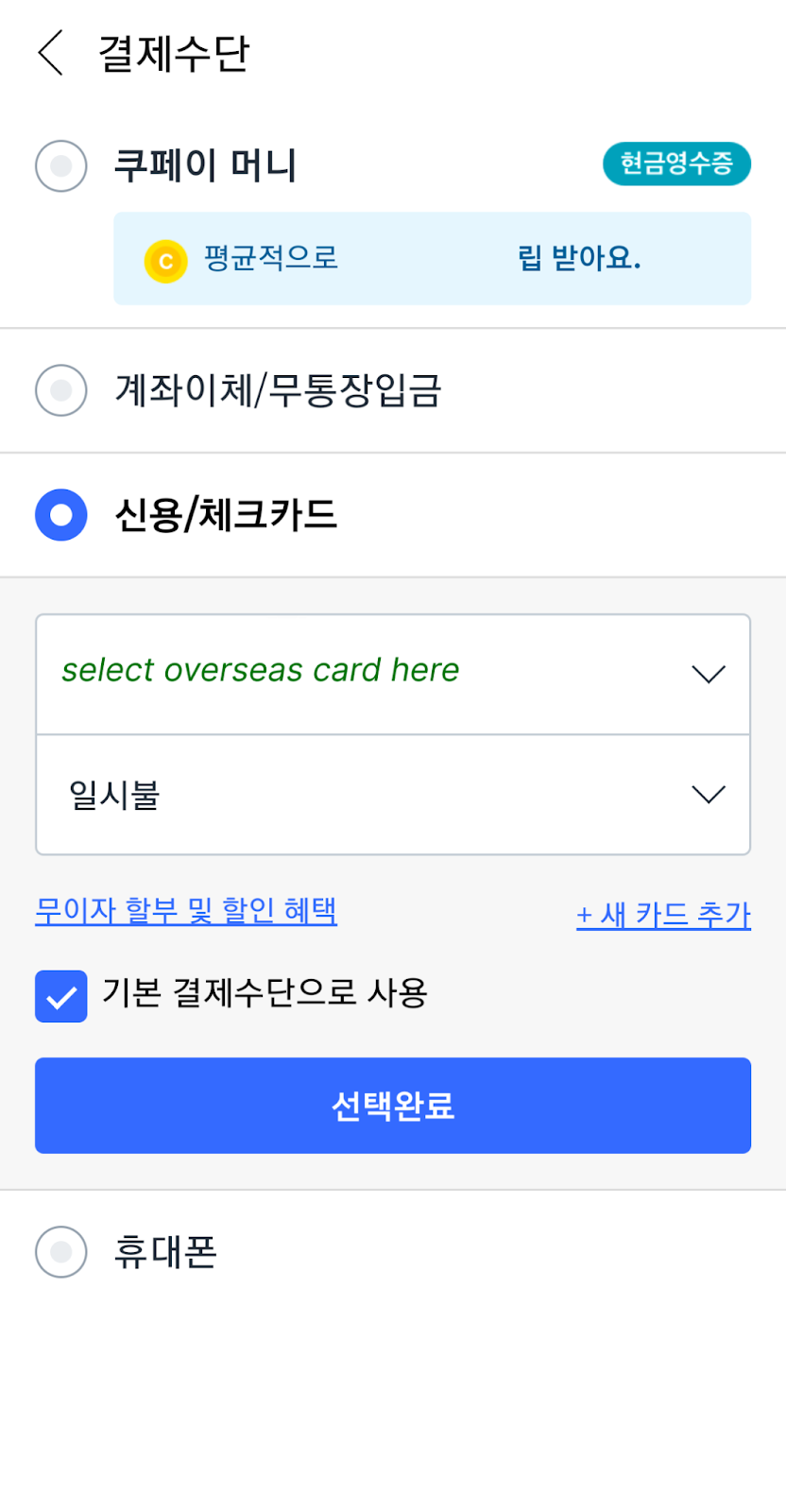
- Click on the card menu and scroll down to select the “해외발급 신용카드 (Overseas Card)” option.
- Select 일시불 (Lump sum payment).
- If you want, select 기본 결제수단으로 사용 (Use as default payment method).
- Then press 선택완료 (Complete selection).
- Enter your card information (Card number, expiration date, and CVV code).
- You can order!
Food Delivery Apps
Ordering food at home is a must in Korea. It’s easy, pretty cheap, and ideal for groups. If you have a resident card, the process is super straightforward. If you don’t, you can still use Coupang Eats (under certain conditions), Baedal Minjok, and Shuttle Delivery. This guide explains how.
Coupang Eats
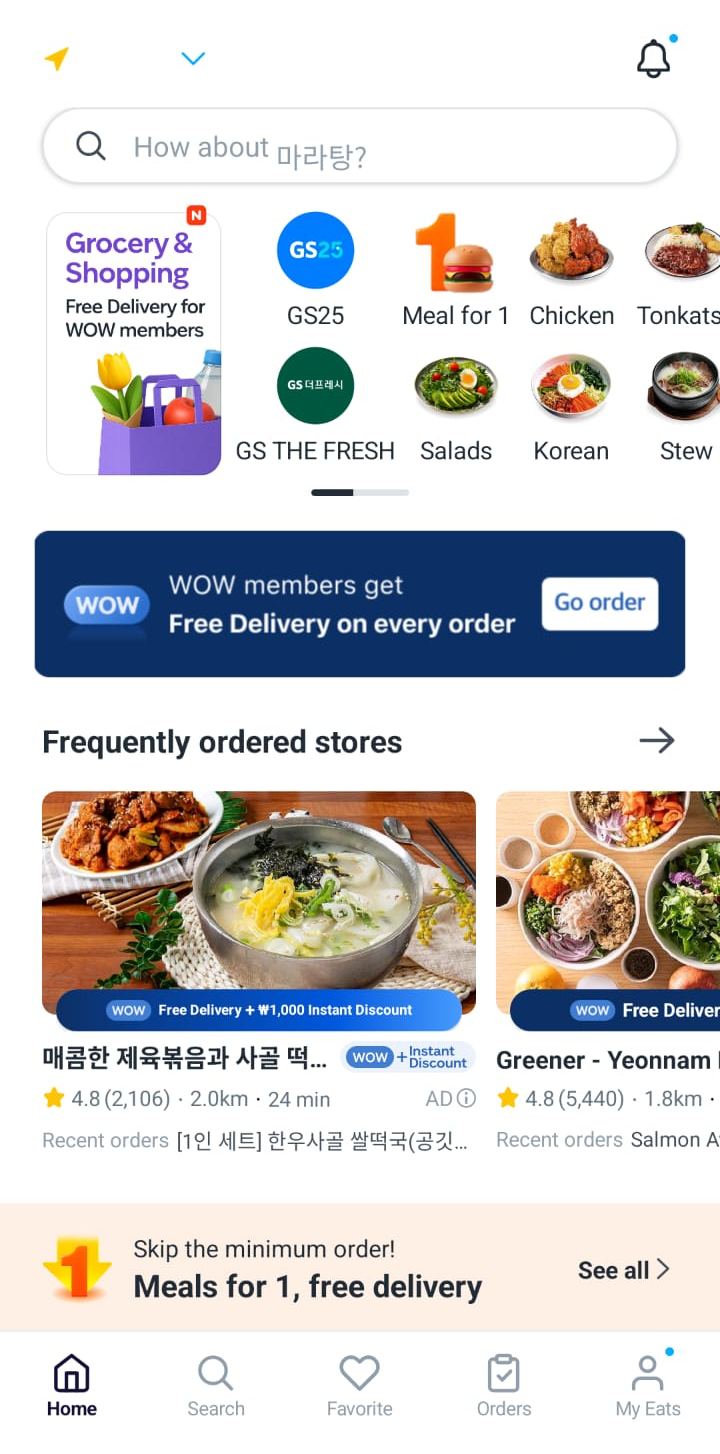
Coupang Eats will work for you only if you have an overseas VISA card. Why does it only work with VISA? We do not know, but it could change at any point. We recommend you try it, just in case, since Coupang Eats is by far the best app to use if you don’t speak Korean.
How to use Coupang Eats with a foreign card
- First, you need to download the Coupang app and make an account.
- Open Coupang Eats. When it asks you how you want to log in, select “Sign in with Coupang App”.
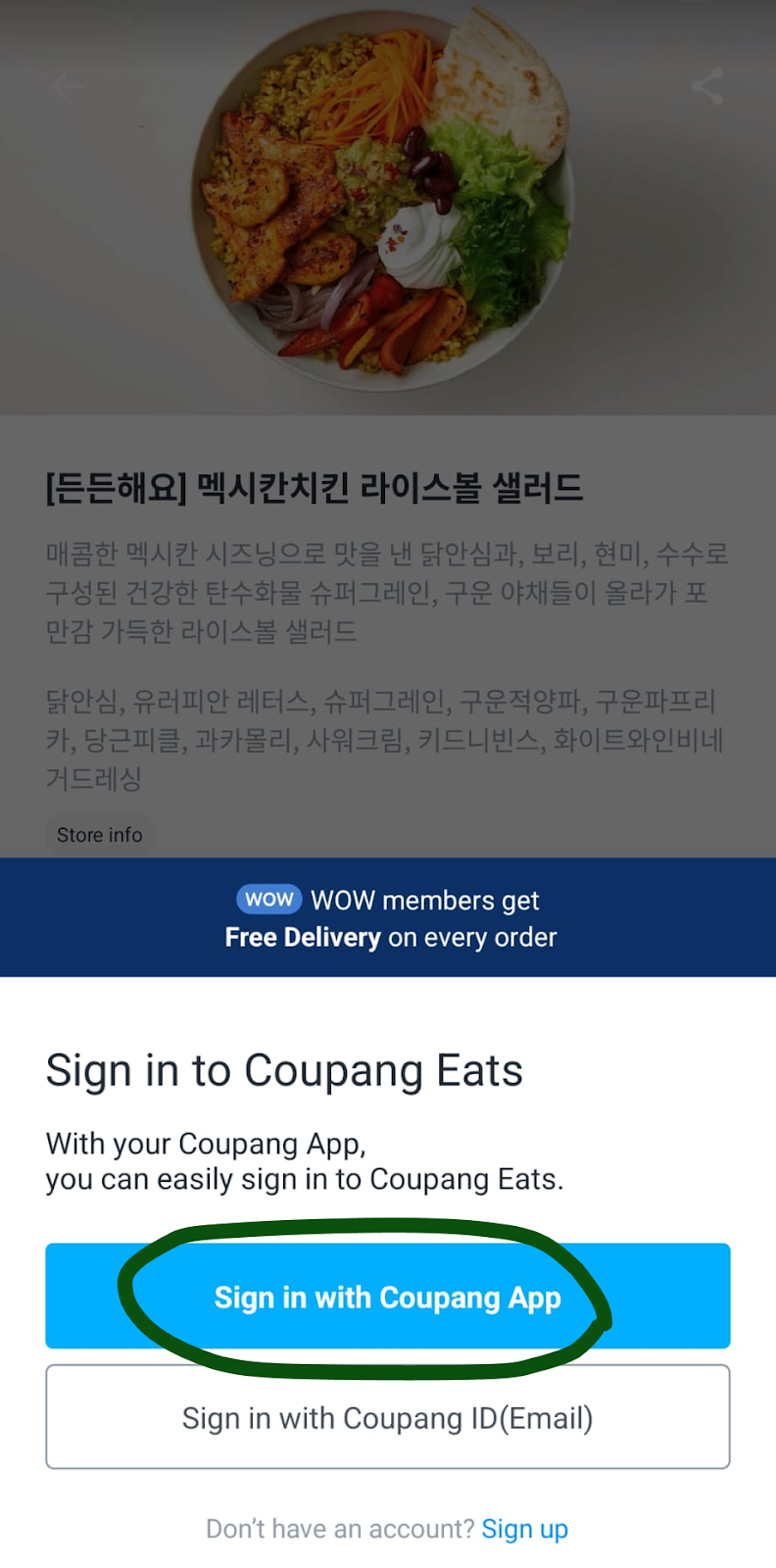
- Once you have signed in, go to the “My Eats” menu at the bottom and select “Payment”.
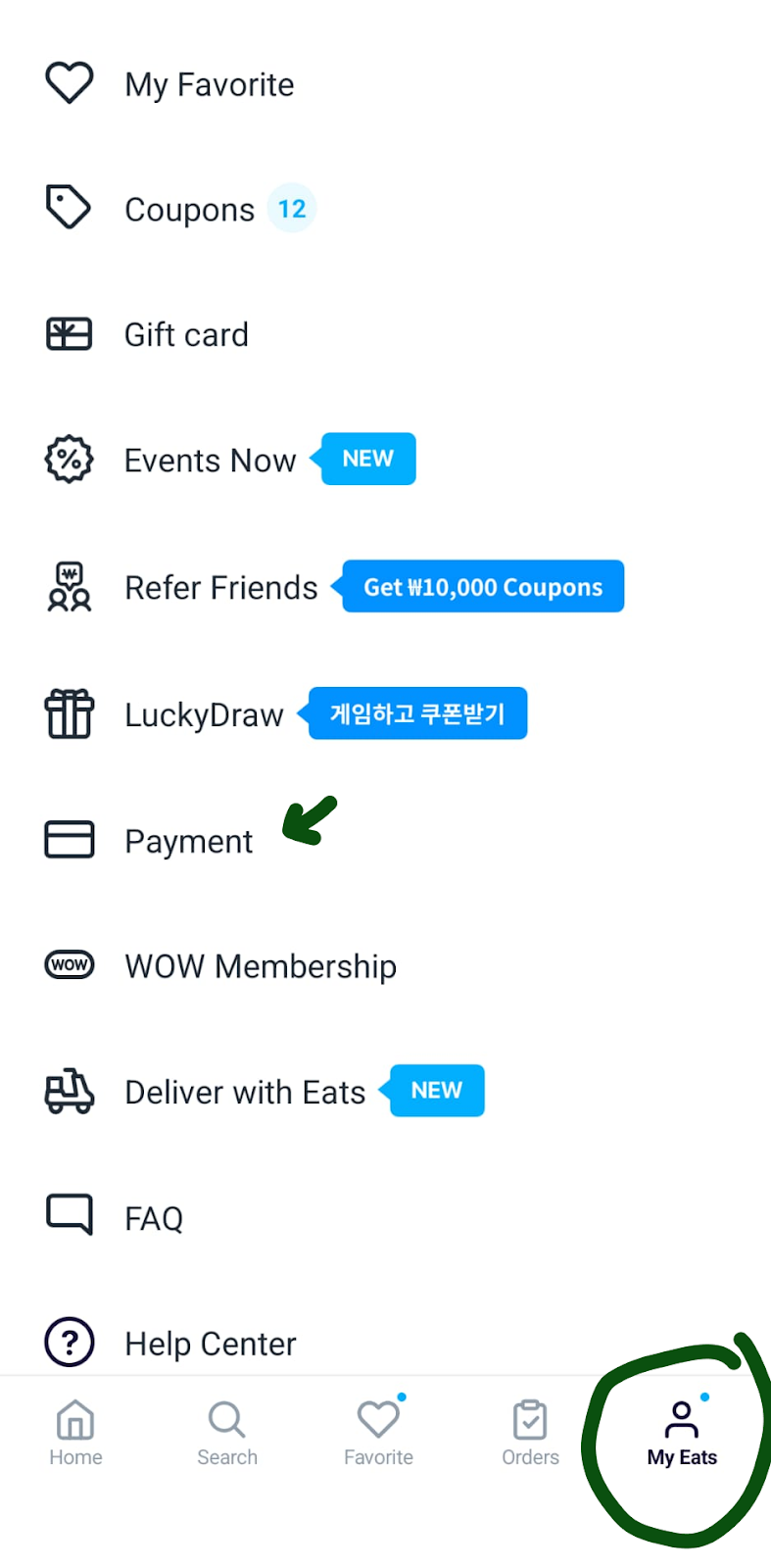
- Select “Add Payment Method”.
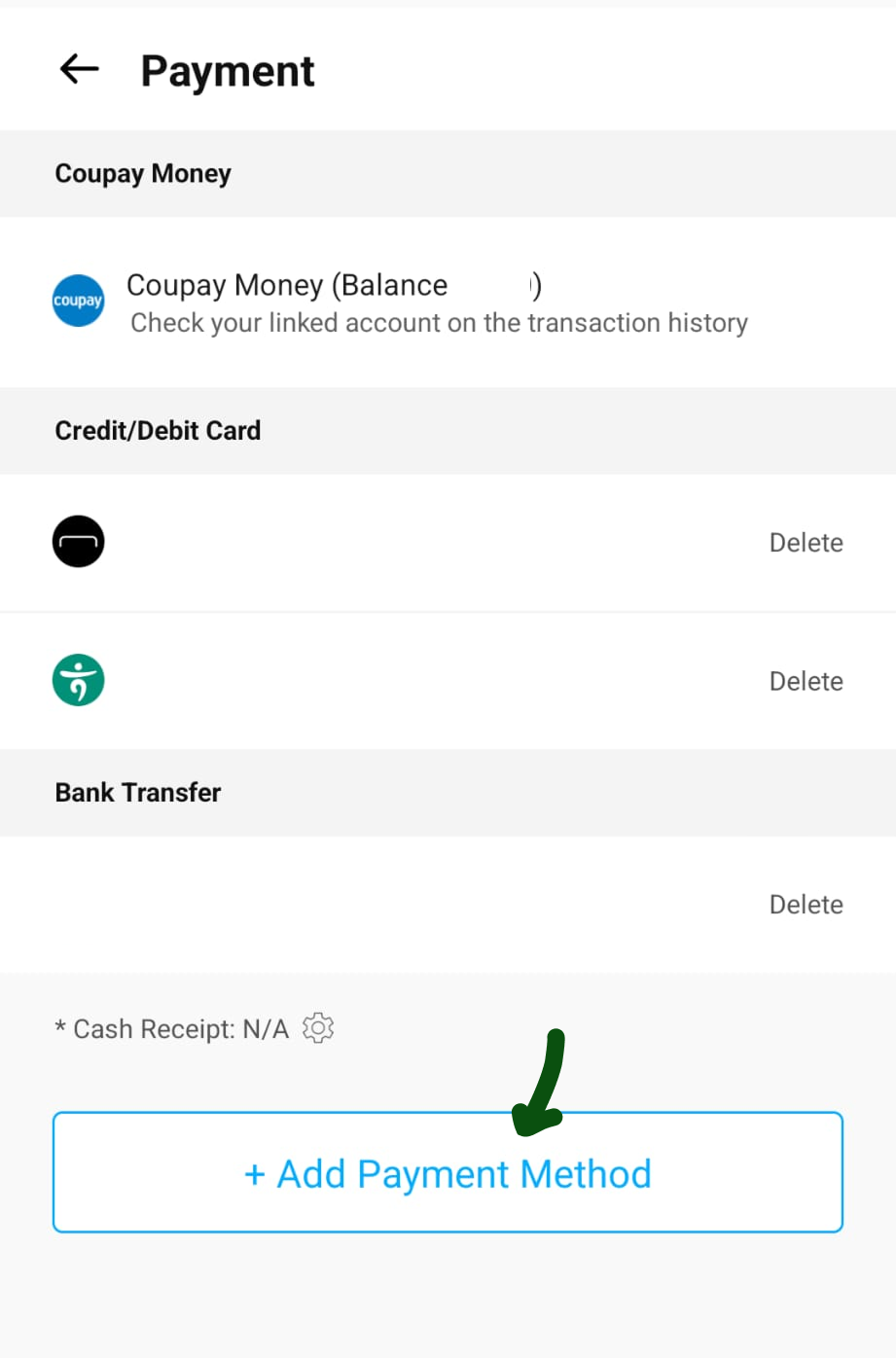
- Click on “here” under the Credit Card option.
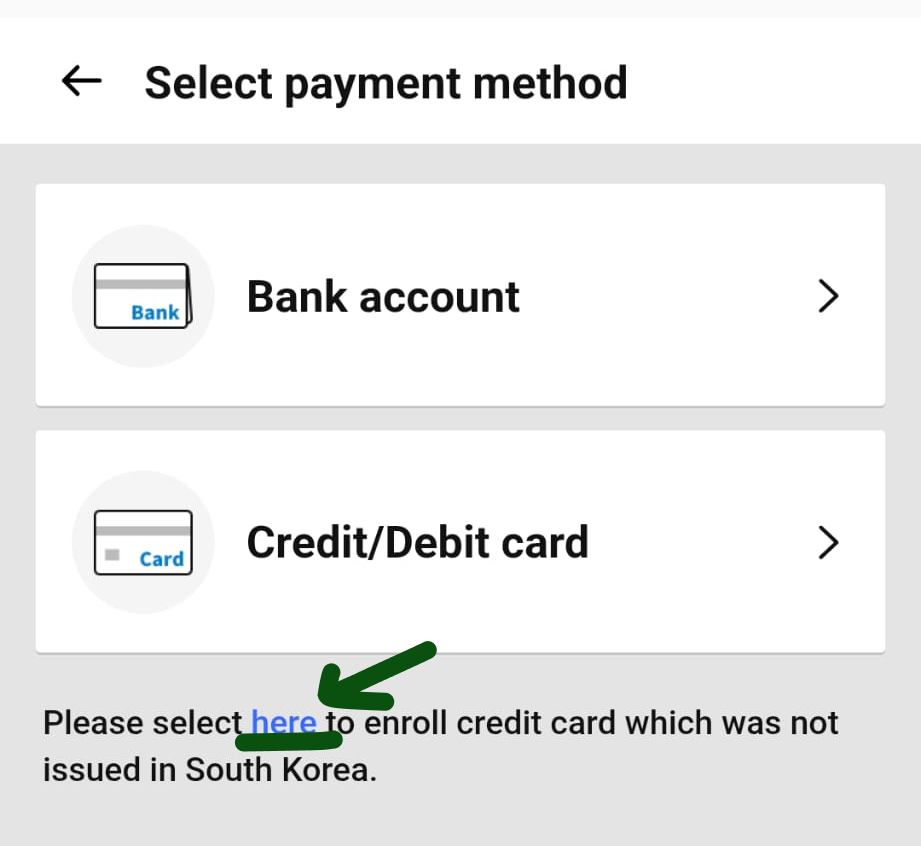
- Then add your VISA card information. You can scan a physical card or add the information manually.
- You might need to verify your card with your bank app.
You’re all set up and can now order delivery from most restaurants in Korea, even groceries.
Baedal Minjok
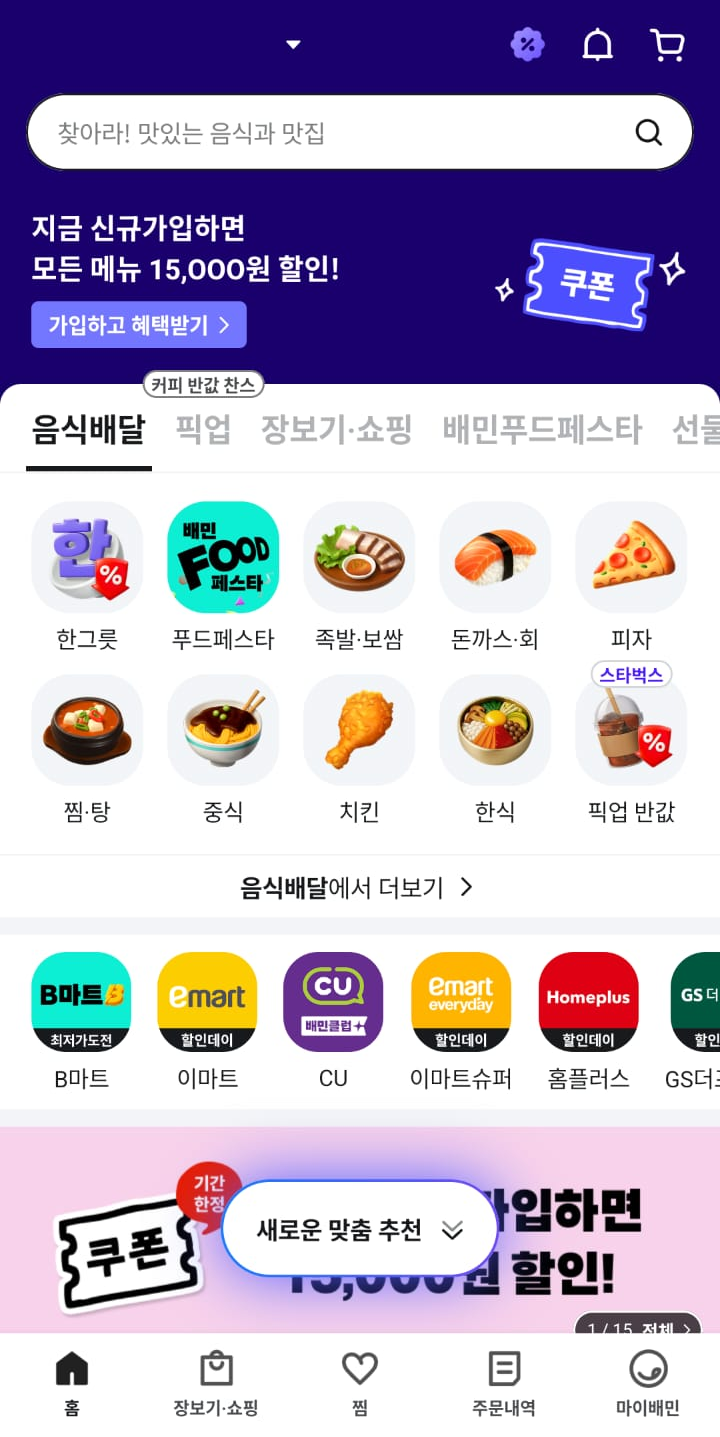
If you do not have a VISA card, don’t worry, you can still use Baedal Minjok. It also offers a lot of options to order food, but the app is fully in Korean.
You can follow this detailed guide to use it.
Shuttle Delivery
If neither of those options works for you, there’s always Shuttle Delivery. The upsides? It’s all in English and very easy to use. The downsides? The app offers very few options when it comes to restaurants and costs a lot more than the other apps in delivery fees...
Second-hand Marketplace
Karrot
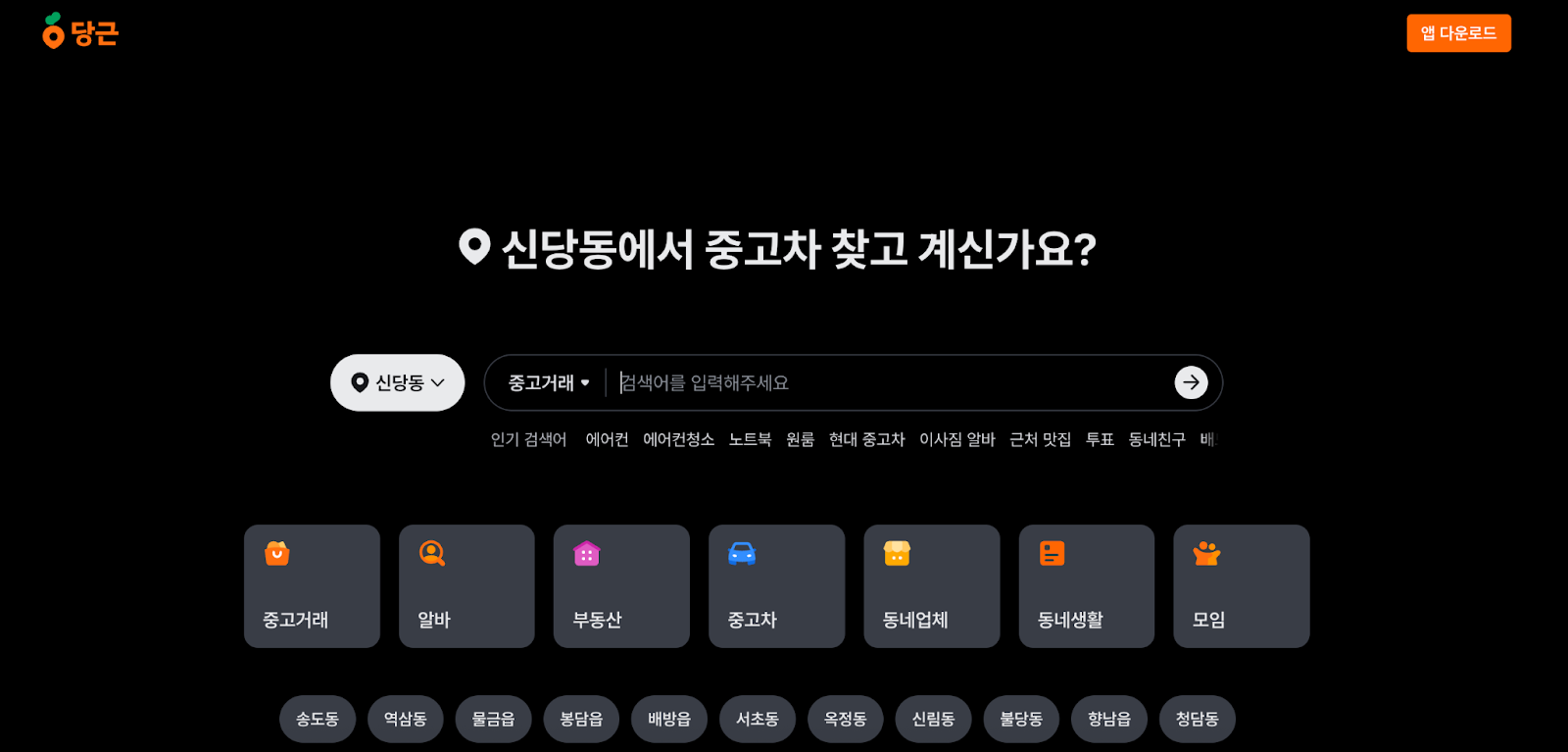
Karrot (or Danggeun Market in Korean) allows you to buy and sell second-hand items. It’s a must if you’re staying in Korea for more than a month and want to buy nicer furniture at a discounted price.
If you’re staying for a short time, prefer a run to Daiso or order on Coupang to buy cheap household essentials.
If you want to know more about living as a Digital Nomad in Korea, you can join our Whatsapp & Discord community, and read the comprehensive guide we wrote on the topic!
FAQ
Why do Koreans have different apps than in other countries?
Like in many other East Asian countries, the Korean company ecosystem is quite closed off. It’s hard for foreign companies to create space to grow in such a protective economy. The tech world, especially, is very hard to get into. Only two American companies have managed to become huge despite the competition: Instagram and Netflix. Apart from those two, nearly every foreign tech giant has a Korean counterpart.
- Naver is Google’s alternative (with many differences in features).
- Kakao doesn’t really have an equivalent in the West and would be better described as a weaker version of Chinese WeChat, offering a strong messaging app, but also taxi, banking, social, and other features across the board.
- Coupang doubles as the local Amazon (they even have their streaming service, Coupang Play) as well as Uber Eats.
Why doesn’t Google Maps work in Korea?
Saying Google Maps doesn’t work in Korea might be a bit exaggerated, but key functionalities are definitely missing. This is due to national security and regulatory reasons. Mainly, strict laws prohibit the export of high-precision map data. This data includes details like sidewalks, pedestrian crossings, and road boundaries, which are essential for Google to offer navigation features such as walking, driving, and biking directions.
As a result, most restaurants and cafes don’t even bother registering on Google Maps, and most establishments are missing. They may not have updated information and could be located at the wrong address.
Fun fact: this is why Niantic released Pokémon Go half a year late in South Korea back in 2016 and 2017. Their mapping data came from Google Maps, and they had to figure out a whole other method to access this data in Korea…
What’s a verified phone number?
When you are a resident in Korea, your ID card allows you to open a bank account, which, in turn, allows you to register for a local “verified phone number” linked to your local ID card. This number is different from the local one you get as a tourist, which is linked to your passport. It’s the way you can verify your identity online, and many Korean apps or services need this to function or allow you to log in. Korea is a very protective country, when it comes to services and its tech-ecosystem… Without this verifiable number, you won’t be able to access everything, but that’s ok. In the last two years, many apps have changed their setup so that you can use a foreign card for payment! You’ll likely still need a local number - but a non-verified one will be enough.
How do I get a verified number in Korea?
You have to be a resident and get a visa, like the digital nomad visa or the startup visa. We wrote a guide to moving to Korea, which covers how to get the number once you receive your resident ID.
Why can’t I find certain Korean apps on the Google Play Store?
Some apps are only available on the Korean store. Create a new local Gmail account, and switch to that account in the Play Store to be able to find the missing apps! Once you have downloaded the app on your phone, you can switch back to your usual account.
Korea: 7 Must-Have Apps for Digital Nomads (2025)
Forget about Google Maps, Uber, and Amazon. In Korea, Naver, Kakao, and Coupang are kings.
In most countries, we use the same apps. There’s often one or two that are specific to a place, but in Korea, forget all about Google Maps, Uber, Amazon...
Enter a new world where Naver, Kakao, and Coupang rule.
In this highly protected kingdom, you won’t be able to use some of the most local apps, as you’ll need a verified phone number to log in or be able to pay. But don’t worry, Korea has made a lot of progress with this in recent years, and the apps we’ve listed can be used whether you have a visa or not.
Spoiler alert: you can now use Coupang and (if you have a VISA card) even Coupang Eats!
We prepared a guide to explain this online adventure with all the major apps that you’ll need, as well as a little FAQ at the end.
Map Apps
Google Maps only works for one thing in Korea: finding vegetarian or vegan restaurants. For the rest, you’ll need a local navigation app like Naver Map and Kakao Map, or, as a last resort, Citymapper. They are a bit more difficult to use, but they have a pretty good English mode nowadays, and you’ll actually get current and detailed information about anywhere you want to go.
Naver Maps

Naver Map is one of the two most-used navigation apps in Korea. It will help you figure out where to go, the opening time, check menus ahead of time, find directions, etc. For residents, it also lets you reserve train tickets, hotels, and many other services in-app. Easier to use than Kakao Maps for non-Korean speakers, Naver Maps usually displays the most updated information.
Naver Maps Tips
- Make sure to set the app fully to English by checking in the settings that ‘언어’ is properly set to ‘English’ and not ‘한국어’ (which means ‘Korean’).
- The app has a little quirk: to find a location by typing its name in English, you need to type it in lower caps, without a space. For example, we often organise Dinner & Drinks Meetups with our community at a bar called Beer O’Clock. To find it on Naver Maps, you’ll need to type ‘beeroclock’.
Kakao Map

Similar to Naver Maps, Kakao Maps focuses less on business and more on real-time traffic navigation. Ratings and reviews for restaurants and cafes on Kakao tend to also be more believable than reviews on Naver, which is very heavily powered by ads. Bus timetables are also more accurate on Kakao than on Naver Maps. A feature even allows you to even see the bus location (you’ll see a little bus and its number displayed on the map), which helps you be more precise with traffic.
Kakao Map Tip
The app can also be more powerful in some cities in the countryside, depending on the contract negotiated with the local authorities. For example, in Jeju Island, there’s a bit more information on Kakao Maps.
Citymapper
Citymapper only works in Seoul, but it has the strong upside of being fully in English since it's a British app. Itineraries work great (the app gets its bus data from Kakao), and you’ll find most places (restaurants, cafes, etc) on the app!
Messenger App
There’s only one messaging app that governs them all in Korea…
KakaoTalk

If you want to get a taste of local life, your best bet is downloading KakaoTalk, the messaging app used by more than 90% of Koreans. You’ll enjoy super cute stickers, being able to schedule your posts (press the sending icon for a few seconds to get the option), and great group functionalities.
Taxi App

Except in dedicated taxi lanes, the use of taxi apps has become so big it has actually become difficult to grab a taxi by waving in the street. Instead, use KakaoT or Uber.
KakaoT
The KakaoT (ex-Kakao Taxi) app is used all over the country. You can use it to book a taxi and pay for it in-app. Other services are available, like renting a bike, an e-scooter, transporting pets, booking train tickets, etc. It works like Uber and Grab - letting you choose different types of rides according to how many people you are, which level of luxury you desire, etc.
KakaoT Tips
- You can select that you want to pay the taxi driver in person (by card, cash, or T-money card), but this might reduce your options since some cabs only accept in-app payment.
- The government and Kakao launched another app, K-ride, before KakaoT added the option to pay directly with a foreign card in the app. Once that feature was added, K-ride stopped making as much sense... We recommend that you just use KakaoT right away.
Uber
Like in most countries, Uber exists in Korea and works well. You might get fewer choices for taxis, and prices might be a bit higher than on KakaoT.
Translation Apps
Papago

Papago, a local option powered by Naver, is the best option when you want to translate voice memos. Paired with the Naver dictionary app, Papago is also great if you’re looking for the translation of one or two words. For sentences or bigger texts, prefer Deepl or AI.
Deepl

Specifically trained to translate in specific languages, Deepl does much better than Google or Papago when it comes to longer texts. It picks up on nuances and was a game-changer before AI came along.
AI

When it comes to translating Korean - a highly contextual language - AI does very well. The AI landscape is changing very fast right now, so it’s hard to keep up with the latest releases, but Perplexity and ChatGPT are our current favorites. You can also use Perplexity for image translation by dragging and dropping an image and asking to translate the text that’s on it.
Google Traduction
For live-image translation, Google Translate remains the fastest and best option out there.
Delivery App
Coupang

Forget Amazon. Korea has Coupang! You can find nearly anything there: furniture, food, plants… They’ll often arrive on the next day, maybe even on the same day if you have a resident card and subscribe to their WOW membership. Coupang is a necessity for many households.
How to use Coupang with a foreign card
If you are not a resident, your first order might require a bit of patience. Here’s how you can order on Coupang without a verified phone number:
- You can order on the Coupang app only, not the website.
- Choose your products, add them to your baskets, then proceed to order.
- You’ll need to give a local phone number (any local number works) and your address.
- In the payment method (결제수단), choose that you want to pay by card: 신용/체크카드 (Credit / Debit card).

- Click on the card menu and scroll down to select the “해외발급 신용카드 (Overseas Card)” option.
- Select 일시불 (Lump sum payment).
- If you want, select 기본 결제수단으로 사용 (Use as default payment method).
- Then press 선택완료 (Complete selection).
- Enter your card information (Card number, expiration date, and CVV code).
- You can order!
Food Delivery Apps
Ordering food at home is a must in Korea. It’s easy, pretty cheap, and ideal for groups. If you have a resident card, the process is super straightforward. If you don’t, you can still use Coupang Eats (under certain conditions), Baedal Minjok, and Shuttle Delivery. This guide explains how.
Coupang Eats

Coupang Eats will work for you only if you have an overseas VISA card. Why does it only work with VISA? We do not know, but it could change at any point. We recommend you try it, just in case, since Coupang Eats is by far the best app to use if you don’t speak Korean.
How to use Coupang Eats with a foreign card
- First, you need to download the Coupang app and make an account.
- Open Coupang Eats. When it asks you how you want to log in, select “Sign in with Coupang App”.

- Once you have signed in, go to the “My Eats” menu at the bottom and select “Payment”.

- Select “Add Payment Method”.

- Click on “here” under the Credit Card option.

- Then add your VISA card information. You can scan a physical card or add the information manually.
- You might need to verify your card with your bank app.
You’re all set up and can now order delivery from most restaurants in Korea, even groceries.
Baedal Minjok

If you do not have a VISA card, don’t worry, you can still use Baedal Minjok. It also offers a lot of options to order food, but the app is fully in Korean.
You can follow this detailed guide to use it.
Shuttle Delivery
If neither of those options works for you, there’s always Shuttle Delivery. The upsides? It’s all in English and very easy to use. The downsides? The app offers very few options when it comes to restaurants and costs a lot more than the other apps in delivery fees...
Second-hand Marketplace
Karrot

Karrot (or Danggeun Market in Korean) allows you to buy and sell second-hand items. It’s a must if you’re staying in Korea for more than a month and want to buy nicer furniture at a discounted price.
If you’re staying for a short time, prefer a run to Daiso or order on Coupang to buy cheap household essentials.
If you want to know more about living as a Digital Nomad in Korea, you can join our Whatsapp & Discord community, and read the comprehensive guide we wrote on the topic!
FAQ
Why do Koreans have different apps than in other countries?
Like in many other East Asian countries, the Korean company ecosystem is quite closed off. It’s hard for foreign companies to create space to grow in such a protective economy. The tech world, especially, is very hard to get into. Only two American companies have managed to become huge despite the competition: Instagram and Netflix. Apart from those two, nearly every foreign tech giant has a Korean counterpart.
- Naver is Google’s alternative (with many differences in features).
- Kakao doesn’t really have an equivalent in the West and would be better described as a weaker version of Chinese WeChat, offering a strong messaging app, but also taxi, banking, social, and other features across the board.
- Coupang doubles as the local Amazon (they even have their streaming service, Coupang Play) as well as Uber Eats.
Why doesn’t Google Maps work in Korea?
Saying Google Maps doesn’t work in Korea might be a bit exaggerated, but key functionalities are definitely missing. This is due to national security and regulatory reasons. Mainly, strict laws prohibit the export of high-precision map data. This data includes details like sidewalks, pedestrian crossings, and road boundaries, which are essential for Google to offer navigation features such as walking, driving, and biking directions.
As a result, most restaurants and cafes don’t even bother registering on Google Maps, and most establishments are missing. They may not have updated information and could be located at the wrong address.
Fun fact: this is why Niantic released Pokémon Go half a year late in South Korea back in 2016 and 2017. Their mapping data came from Google Maps, and they had to figure out a whole other method to access this data in Korea…
What’s a verified phone number?
When you are a resident in Korea, your ID card allows you to open a bank account, which, in turn, allows you to register for a local “verified phone number” linked to your local ID card. This number is different from the local one you get as a tourist, which is linked to your passport. It’s the way you can verify your identity online, and many Korean apps or services need this to function or allow you to log in. Korea is a very protective country, when it comes to services and its tech-ecosystem… Without this verifiable number, you won’t be able to access everything, but that’s ok. In the last two years, many apps have changed their setup so that you can use a foreign card for payment! You’ll likely still need a local number - but a non-verified one will be enough.
How do I get a verified number in Korea?
You have to be a resident and get a visa, like the digital nomad visa or the startup visa. We wrote a guide to moving to Korea, which covers how to get the number once you receive your resident ID.
Why can’t I find certain Korean apps on the Google Play Store?
Some apps are only available on the Korean store. Create a new local Gmail account, and switch to that account in the Play Store to be able to find the missing apps! Once you have downloaded the app on your phone, you can switch back to your usual account.
Korea: 7 Must-Have Apps for Digital Nomads (2025)
Forget about Google Maps, Uber, and Amazon. In Korea, Naver, Kakao, and Coupang are kings.
In most countries, we use the same apps. There’s often one or two that are specific to a place, but in Korea, forget all about Google Maps, Uber, Amazon...
Enter a new world where Naver, Kakao, and Coupang rule.
In this highly protected kingdom, you won’t be able to use some of the most local apps, as you’ll need a verified phone number to log in or be able to pay. But don’t worry, Korea has made a lot of progress with this in recent years, and the apps we’ve listed can be used whether you have a visa or not.
Spoiler alert: you can now use Coupang and (if you have a VISA card) even Coupang Eats!
We prepared a guide to explain this online adventure with all the major apps that you’ll need, as well as a little FAQ at the end.
Map Apps
Google Maps only works for one thing in Korea: finding vegetarian or vegan restaurants. For the rest, you’ll need a local navigation app like Naver Map and Kakao Map, or, as a last resort, Citymapper. They are a bit more difficult to use, but they have a pretty good English mode nowadays, and you’ll actually get current and detailed information about anywhere you want to go.
Naver Maps

Naver Map is one of the two most-used navigation apps in Korea. It will help you figure out where to go, the opening time, check menus ahead of time, find directions, etc. For residents, it also lets you reserve train tickets, hotels, and many other services in-app. Easier to use than Kakao Maps for non-Korean speakers, Naver Maps usually displays the most updated information.
Naver Maps Tips
- Make sure to set the app fully to English by checking in the settings that ‘언어’ is properly set to ‘English’ and not ‘한국어’ (which means ‘Korean’).
- The app has a little quirk: to find a location by typing its name in English, you need to type it in lower caps, without a space. For example, we often organise Dinner & Drinks Meetups with our community at a bar called Beer O’Clock. To find it on Naver Maps, you’ll need to type ‘beeroclock’.
Kakao Map

Similar to Naver Maps, Kakao Maps focuses less on business and more on real-time traffic navigation. Ratings and reviews for restaurants and cafes on Kakao tend to also be more believable than reviews on Naver, which is very heavily powered by ads. Bus timetables are also more accurate on Kakao than on Naver Maps. A feature even allows you to even see the bus location (you’ll see a little bus and its number displayed on the map), which helps you be more precise with traffic.
Kakao Map Tip
The app can also be more powerful in some cities in the countryside, depending on the contract negotiated with the local authorities. For example, in Jeju Island, there’s a bit more information on Kakao Maps.
Citymapper
Citymapper only works in Seoul, but it has the strong upside of being fully in English since it's a British app. Itineraries work great (the app gets its bus data from Kakao), and you’ll find most places (restaurants, cafes, etc) on the app!
Messenger App
There’s only one messaging app that governs them all in Korea…
KakaoTalk

If you want to get a taste of local life, your best bet is downloading KakaoTalk, the messaging app used by more than 90% of Koreans. You’ll enjoy super cute stickers, being able to schedule your posts (press the sending icon for a few seconds to get the option), and great group functionalities.
Taxi App

Except in dedicated taxi lanes, the use of taxi apps has become so big it has actually become difficult to grab a taxi by waving in the street. Instead, use KakaoT or Uber.
KakaoT
The KakaoT (ex-Kakao Taxi) app is used all over the country. You can use it to book a taxi and pay for it in-app. Other services are available, like renting a bike, an e-scooter, transporting pets, booking train tickets, etc. It works like Uber and Grab - letting you choose different types of rides according to how many people you are, which level of luxury you desire, etc.
KakaoT Tips
- You can select that you want to pay the taxi driver in person (by card, cash, or T-money card), but this might reduce your options since some cabs only accept in-app payment.
- The government and Kakao launched another app, K-ride, before KakaoT added the option to pay directly with a foreign card in the app. Once that feature was added, K-ride stopped making as much sense... We recommend that you just use KakaoT right away.
Uber
Like in most countries, Uber exists in Korea and works well. You might get fewer choices for taxis, and prices might be a bit higher than on KakaoT.
Translation Apps
Papago

Papago, a local option powered by Naver, is the best option when you want to translate voice memos. Paired with the Naver dictionary app, Papago is also great if you’re looking for the translation of one or two words. For sentences or bigger texts, prefer Deepl or AI.
Deepl

Specifically trained to translate in specific languages, Deepl does much better than Google or Papago when it comes to longer texts. It picks up on nuances and was a game-changer before AI came along.
AI

When it comes to translating Korean - a highly contextual language - AI does very well. The AI landscape is changing very fast right now, so it’s hard to keep up with the latest releases, but Perplexity and ChatGPT are our current favorites. You can also use Perplexity for image translation by dragging and dropping an image and asking to translate the text that’s on it.
Google Traduction
For live-image translation, Google Translate remains the fastest and best option out there.
Delivery App
Coupang

Forget Amazon. Korea has Coupang! You can find nearly anything there: furniture, food, plants… They’ll often arrive on the next day, maybe even on the same day if you have a resident card and subscribe to their WOW membership. Coupang is a necessity for many households.
How to use Coupang with a foreign card
If you are not a resident, your first order might require a bit of patience. Here’s how you can order on Coupang without a verified phone number:
- You can order on the Coupang app only, not the website.
- Choose your products, add them to your baskets, then proceed to order.
- You’ll need to give a local phone number (any local number works) and your address.
- In the payment method (결제수단), choose that you want to pay by card: 신용/체크카드 (Credit / Debit card).

- Click on the card menu and scroll down to select the “해외발급 신용카드 (Overseas Card)” option.
- Select 일시불 (Lump sum payment).
- If you want, select 기본 결제수단으로 사용 (Use as default payment method).
- Then press 선택완료 (Complete selection).
- Enter your card information (Card number, expiration date, and CVV code).
- You can order!
Food Delivery Apps
Ordering food at home is a must in Korea. It’s easy, pretty cheap, and ideal for groups. If you have a resident card, the process is super straightforward. If you don’t, you can still use Coupang Eats (under certain conditions), Baedal Minjok, and Shuttle Delivery. This guide explains how.
Coupang Eats

Coupang Eats will work for you only if you have an overseas VISA card. Why does it only work with VISA? We do not know, but it could change at any point. We recommend you try it, just in case, since Coupang Eats is by far the best app to use if you don’t speak Korean.
How to use Coupang Eats with a foreign card
- First, you need to download the Coupang app and make an account.
- Open Coupang Eats. When it asks you how you want to log in, select “Sign in with Coupang App”.

- Once you have signed in, go to the “My Eats” menu at the bottom and select “Payment”.

- Select “Add Payment Method”.

- Click on “here” under the Credit Card option.

- Then add your VISA card information. You can scan a physical card or add the information manually.
- You might need to verify your card with your bank app.
You’re all set up and can now order delivery from most restaurants in Korea, even groceries.
Baedal Minjok

If you do not have a VISA card, don’t worry, you can still use Baedal Minjok. It also offers a lot of options to order food, but the app is fully in Korean.
You can follow this detailed guide to use it.
Shuttle Delivery
If neither of those options works for you, there’s always Shuttle Delivery. The upsides? It’s all in English and very easy to use. The downsides? The app offers very few options when it comes to restaurants and costs a lot more than the other apps in delivery fees...
Second-hand Marketplace
Karrot

Karrot (or Danggeun Market in Korean) allows you to buy and sell second-hand items. It’s a must if you’re staying in Korea for more than a month and want to buy nicer furniture at a discounted price.
If you’re staying for a short time, prefer a run to Daiso or order on Coupang to buy cheap household essentials.
If you want to know more about living as a Digital Nomad in Korea, you can join our Whatsapp & Discord community, and read the comprehensive guide we wrote on the topic!
FAQ
Why do Koreans have different apps than in other countries?
Like in many other East Asian countries, the Korean company ecosystem is quite closed off. It’s hard for foreign companies to create space to grow in such a protective economy. The tech world, especially, is very hard to get into. Only two American companies have managed to become huge despite the competition: Instagram and Netflix. Apart from those two, nearly every foreign tech giant has a Korean counterpart.
- Naver is Google’s alternative (with many differences in features).
- Kakao doesn’t really have an equivalent in the West and would be better described as a weaker version of Chinese WeChat, offering a strong messaging app, but also taxi, banking, social, and other features across the board.
- Coupang doubles as the local Amazon (they even have their streaming service, Coupang Play) as well as Uber Eats.
Why doesn’t Google Maps work in Korea?
Saying Google Maps doesn’t work in Korea might be a bit exaggerated, but key functionalities are definitely missing. This is due to national security and regulatory reasons. Mainly, strict laws prohibit the export of high-precision map data. This data includes details like sidewalks, pedestrian crossings, and road boundaries, which are essential for Google to offer navigation features such as walking, driving, and biking directions.
As a result, most restaurants and cafes don’t even bother registering on Google Maps, and most establishments are missing. They may not have updated information and could be located at the wrong address.
Fun fact: this is why Niantic released Pokémon Go half a year late in South Korea back in 2016 and 2017. Their mapping data came from Google Maps, and they had to figure out a whole other method to access this data in Korea…
What’s a verified phone number?
When you are a resident in Korea, your ID card allows you to open a bank account, which, in turn, allows you to register for a local “verified phone number” linked to your local ID card. This number is different from the local one you get as a tourist, which is linked to your passport. It’s the way you can verify your identity online, and many Korean apps or services need this to function or allow you to log in. Korea is a very protective country, when it comes to services and its tech-ecosystem… Without this verifiable number, you won’t be able to access everything, but that’s ok. In the last two years, many apps have changed their setup so that you can use a foreign card for payment! You’ll likely still need a local number - but a non-verified one will be enough.
How do I get a verified number in Korea?
You have to be a resident and get a visa, like the digital nomad visa or the startup visa. We wrote a guide to moving to Korea, which covers how to get the number once you receive your resident ID.
Why can’t I find certain Korean apps on the Google Play Store?
Some apps are only available on the Korean store. Create a new local Gmail account, and switch to that account in the Play Store to be able to find the missing apps! Once you have downloaded the app on your phone, you can switch back to your usual account.



